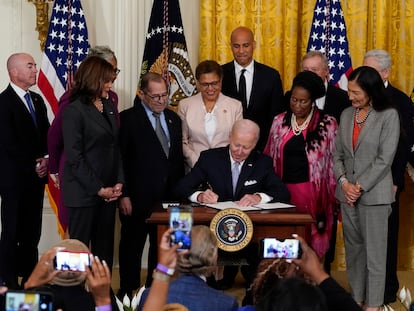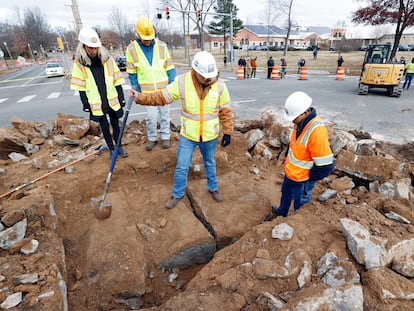Richmond took down its racist statues. But now, the city doesn’t know what to do with them
In a secret warehouse in the old capital of the Confederacy, authorities store monuments that were removed from public places during the 2020 anti-racism protests. EL PAÍS received exclusive access to the location where the fate of these objects is being decided

Richmond’s racist past – torn in pieces – awaits its future, stacked up in a wasteland next to the river that runs through the capital of Virginia. EL PAÍS recently accessed this secret storage site, on the condition that it not reveal or give clues about its location for security reasons.
In an open-air industrial area, the remains of Confederate statues lie. They were removed from the streets by the Richmond City Council in the aftermath of protests that broke out in May 2020, following the murder of George Floyd in Minneapolis, Minnesota. His killing – at the hands of a police officer – sparked international anti-racism protests and an iconoclastic wave that swept across the United States, challenging the country’s historical memory.
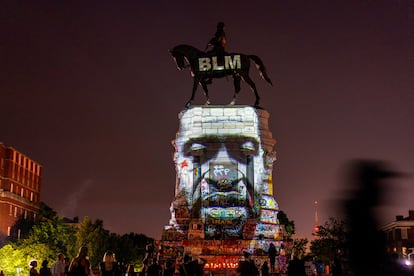
The statues were erected as part of a nostalgic rewriting of the past: an interpretation of the American Civil War known as the “Lost Cause,” promoted by the descendants of the Confederate forces, who were defeated in 1865.
Richmond was the capital of the secessionist and slave-owning American South. The city of 230,000 residents recently transferred ownership of the fallen memorials of Confederate generals and politicians to the Black History Museum and Cultural Center of Virginia. It is now up to the institution to decide what to do with them.
Should they be returned to the streets, or destroyed? Should they be contextualized and put on display? Or perhaps the bronze should be melted down, with the hundreds of tons of marble and granite put to use for better purposes?
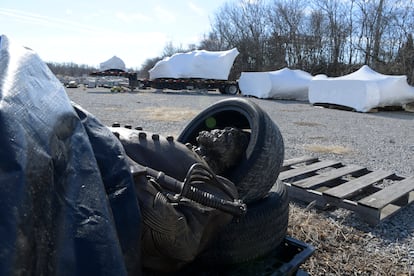
Mary C. Lauderdale – the Black History Museum’s director of collections – is clear on two things: that the decision will be made “in agreement with the community” (“we’re already surveying the residents,” she notes) and that she doesn’t want the statues in the museum’s headquarters – a former barracks that housed Virginia’s first detachment of Black soldiers.
“[The statues] are too big for our space… [they] would require us to strengthen security against possible attacks by white supremacist groups,” she adds.
Another certainty is that the rush to tear them down will not influence the speed of the subsequent steps taken by the authorities. “It will take us a long time. I estimate at least five years, maybe 10,” Lauderdale explains, as she walks among the stone blocks that formed the pedestals of the monuments.
The statues are preserved as they were after the attacks that took place during the summer of discontent in 2020. Graffiti invoking the Black Lives Matter movement is everywhere: there are calls to defund the police and the names of victims who died in police custody. The entire space is a testimony of those turbulent months. The place exudes a solemn air. It is not by chance that the workers who guard the warehouse refer to it as “the boneyard.”

The storage wasteland is a carefully organized graveyard of America’s racist past. The remains of General Robert E. Lee – glorified by a statue that is 60 feet tall and was once the largest on Richmond’s Monument Avenue – takes up about half the space. In the background is a slab dedicated to “Stonewall” Jackson, who earned his nickname at the First Battle of Manassas, which was fought only 30 miles south of Washington, D.C. at the start of the Civil War (1861-65). Each work has a code – they can reassemble the monumental puzzle if necessary.
The bronze figures are at the other end of the site, wrapped in white plastic material, reminiscent of a shroud. They are covered to avoid attracting the attention of drivers who use the nearby highway. Lauderdale says that she and the museum’s staff worry about vandals, extremist groups and collectors of historical memorabilia.
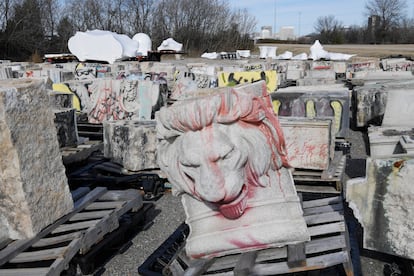
Disassembly and storage was done by Devon Henry, a young Black contractor. In 2020, he received a call from then-governor Ralph Northam – a Democrat – who offered him a commission that no white businessman had dared accept.
“I had to think about it a lot, above all, because of my family, because of the violence and hatred that sparked the controversy with the statues,” he tells EL PAÍS, in a public place on the outskirts of Richmond.
“In the end, I made up my mind: if we didn’t do it now – if I didn’t do it – perhaps what we descendants of enslaved people have been chasing for decades would never come.” Later, he learned that “two dozen companies” rejected the offer before he did.
Henry says that every time he was asked to remove a statue, the authorities gave him “24-hour security.” He had to go to work “wearing a bulletproof vest.” In addition, he obtained a weapons license to feel “protected.”
“Every time we removed one [statue], the calls and messages on the answering machine rained down with threats like: ‘Hello, we’re from the Ku Klux Klan; you knocked down our memories, now it’s our turn to go after you and yours.’ When this article is published, we’ll definitely receive a few more.”
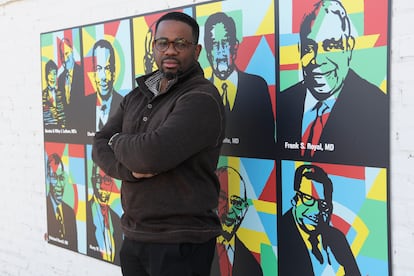
Henry is now willing to “turn the page” and dedicate himself to “more constructive” tasks, such as getting the house belonging to Richmond’s first Black owner back on its feet. His demolition job finished last December, when he removed the statue of Confederate General A.P. Hill, which has since been kept in the secret warehouse, with its head dishonorably stuck in a tire, waiting to be wrapped up in white plastic.
Hill – a lieutenant general in the Lost Cause – was second-in-command of the Confederate army near the end of the war. However, it took a long time to deal with his monument, because his remains were buried underneath the pedestal, thus delaying the operation.
Hill’s indirect descendants – who sued the city for ownership of the statue – were buried a couple of Saturdays ago in Culpeper, a Virginia town north of Richmond. The ceremony was attended by hundreds of supporters of the Confederacy, many of them dressed in the regalia of the Civil War.
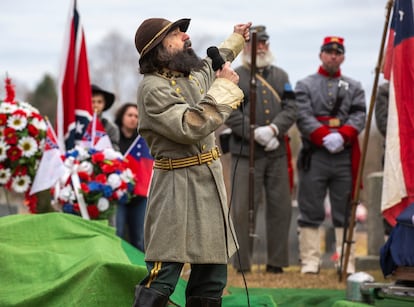
Henry estimates that he has dismantled 24 structures between Richmond and Charlottesville. The latter is home to the University of Virginia and is one of the cities that acknowledged historical pain and chose to melt down and reuse the materials. In response to the “million dollar question” of what he would do with the monuments if the decision were up to him, he replies: “I don’t think they should be on the street in full view of my children. They cannot be taught without context that explains the racism that lies behind that glorification.”
The only monument of the lot currently on display in Richmond is at The Valentine – a local history museum situated downtown, which houses the collection of Mann Valentine, who became rich in the 19th century after inventing a tonic made from beef juice with supposedly curative properties. The Valentine also hosts the study of Mann’s brother, Edward, a sculptor associated with the iconography of the Lost Cause.
Edward Valentine created the statue that is exhibited within the house: it depicts Confederate president Jefferson Davis. It was toppled by protesters during the 2020 protests. They also toppled an effigy of Columbus, which ended up in a pond. The city of Richmond just donated it to the Italian-American Cultural Association of Virginia.
Richmond residents now have a new perspective of Davis, who used to be perched above them. Today, at The Valentine, he is shown lying down, covered in graffiti, with his arms outstretched in what appears to be an imploring gesture. His forehead is dented from blows – a piece of tissue paper is stuck to his shirt collar.
Bill Martin – who has been in charge of the museum for the past 28 years – remembers that, when they decided to display the statue “without cleaning it,” they caused a noisy reaction. Many people expressed their disgust “for the lack of respect” on social media, or angrily called up the museum.
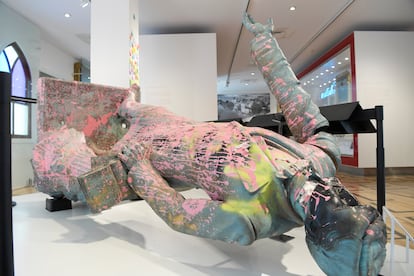
The exhibition is complemented by some panels that tell the story of “how did the monument come down.” There’s also an effective summary of what the Lost Cause wanted: “After Union won the Civil War, supporters of the Confederacy developed the Lost Cause Mythology to justify their loss. They waged this disinformation campaign through the news, in schools, and with monuments.”
These monuments, writes historian Karen L. Cox in the essay No Common Ground, “dominated the southern landscape for more than 150 years.” They still do: according to a report by the independent Southern Poverty Law Center, 2,089 nostalgic vestiges remain under the Mason-Dixon line, which divides the country geographically and mentally.
In Richmond, the generals – who were either seated or on horseback – may have tumbled, but the streets are still far from having achieved “deconfederation.” Such examples of this secessionist past include Robert E. Lee Bridge or Confederate Avenue. There is also a standing statue of Stonewall Jackson. It is in front of the Capitol building, on territory owned by the state of Virginia, now governed by Republican Glenn Youngkin.
Promoters of the Lost Cause offer “a reflection of a culture of violence and white supremacy,” according to Cox. She explains that they have downplayed the horrors of slavery and denied it as a casus belli (“occasion for war”). They have long tried to pass off the Confederates as heroes and secession as a legal act.
Those ideas “seeped into everyday life, ultimately changing the public’s memory of history”, during the Reconstruction [post-war] years and the Jim Crow era [the segregationist system in the southern states], “ultimately changing the way someone – even today – remembers the past. The power of the Lost Cause still affects us today”, The Valentine states in its exhibition.
In the museum, some sheets are distributed, inviting visitors to participate in a survey about the future of Richmond’s racist statues. There are six options: store them, relocate them – with or without context – exhibit them in a museum, reuse the material to create other works of art, or, simply, destroy them.
Martin shares his “surprise” to see that in the “limited scope polls” that have been conducted so far (with a sample of about 3,000 people), the percentage of African-Americans who support the removal of the statues and the percentage of those to whom the matter “isn’t of concern” is very similar: around 40%. It’s the same percentage, he adds, that is observed within the white community. Those responsible for deciding on the destination of the monuments will work with this data, along with other surveys carried out online.
For now, the immediate destination of the Davis statue is clear: in the fall, it will travel to Los Angeles, where two of the city’s museums – MOCA and LAXART – are preparing an exhibition that will display toppled Confederate monuments from around the country, alongside works by contemporary African-American artists.
A LAXART spokeswoman explained in an email last week that the idea came before the death of George Floyd, “following the actions of white supremacists in Charleston in 2015 and Charlottesville in 2017.” In the university town of Charlottesville, the campaign to remove Confederate monuments led to a racist march that caused three deaths. It also marked the beginning of the Trump presidency.
The director of The Valentine is willing to permanently house the statue of Davis when it returns from Los Angeles. “It is important to us; both to tell how [sculptor] Edward Valentine contributed to the Lost Cause, and because it is direct history from what happened in Richmond in 2020. It was the first [monument] to fall. It’s a very powerful item.”

It certainly is for Dustin Klein and Alex Criqui, who remember those days vividly. They participated in the 2020 protests from the beginning, but everything – including their own lives – changed when they had the idea of projecting messages from the Black Lives Matter movement onto Robert E. Lee’s monument. After a few weeks, they then projected photos of victims of police violence, along with images of key figures in African-American history, from Harriet Tubman to Frederick Douglass, onto the vandalized statue. The images from that project – which Klein and Criqui titled Reclaiming the Monument – circulated around the world, turning Richmond into a global symbol in the anti-racism crusade.
Today, the square – where the gigantic statue once stood – has been renamed by activists after Marcus-David Peters, an unarmed victim of police brutality. It now stands empty and fenced off, waiting to be turned into a public garden.
Lee was, in 1890, the first Confederate to be placed on Monument Avenue – a lucrative real estate operation in the heart of the Lost Cause. That same year, John Mitchell – a prophetic local Black journalist, editor of the Richmond Planet newspaper – wrote: “The Negro… put up the Lee monument,” Mitchell wrote, “and should the time come, will be there to take it down.”
The last memorial on the street was unveiled in 1925. Klein smiles as he recalls that, today, only one great man remains on Monument Avenue: a statue unveiled in 1995 – amid protests by white supremacists – honoring local tennis legend Arthur Ashe (1943-1993), who was the first African-American to triumph at Wimbledon.
General Lee was also meant to be the first to go, but ended up being the last on the avenue to disappear, supposedly because – according to Criqui – governor Northam’s June 2020 removal order was delayed by a year due to a lawsuit from “very old and wealthy” people. Speaking to EL PAÍS from where he and Klein used to make their projections, he explains that these individuals “didn’t want to lose the tax exemptions” associated with the “historic” designation of the district. The case was eventually resolved in the Virginia Supreme Court.
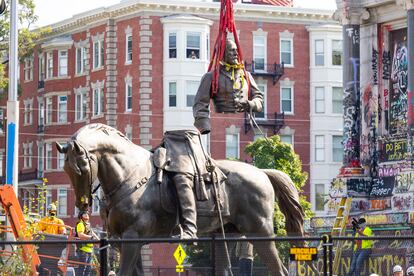
Criqui is in favor of displaying the statues, provided that they are accompanied “with the complete story.”
“Without cleaning them, or fixing them. These objects tell us about some white supremacists who lost the war and tried to win another: the war over memory. We grew up with those lies, eventually, the city ended up rejecting them. The image of Richmond as that little place where the ideals of the Confederacy were still alive was shaken,” he emphasizes.
That racist arcadia ended up becoming a mostly African-American city. The demographics of Richmond – whose population has grown by 15% since 2010 – has flipped around during these years. Due to a gentrification process accelerated by the pandemic, the Black community has gone from being the majority (57% in 2000) to the majority-minority, representing 45.2%, compared a white population of 44.8%. It is also a young population, with an average age of 34.
“The new generations and newcomers demand that we review the past and retell it,” says museum director Bill Martin.
Thinking of this community, the municipal authorities installed another equestrian figure on a pedestal in the city. It depicts a Black man on a horse wearing Nike sneakers. The work – titled Rumors of War – was sculpted by Kehinde Wiley, an African-American artist. It was welcomed by the Virginia Museum of Fine Arts shortly before the pandemic.
Wiley – who painted Barack Obama’s avant garde presidential portrait – has built his successful career by representing his people in a way that the great masters of ancient art reserved for kings.
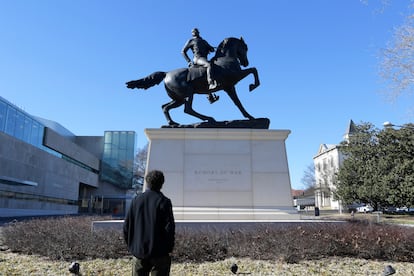
The bronze and stone monument sports a similar gesture to that of J.E.B. Stuart, another toppled statue in Richmond. Wiley’s figure looks askance at the headquarters of the United Daughters of the Confederacy (UDC), founded in 1894. It is estimated that, in the 20th century, the female descendants of Confederate officers financed the construction of between 450 and 700 monuments dedicated to the Lost Cause.
During the 2020 riots, the fortress-like venue came under attack. Today, “No Trespassing” and “Private Property” signs – along with an African-American guard – block visitors from entering. The UDC’s president general, Jinny Widowski, did not respond to this newspaper’s request for comment. On the group’s website, she signs a letter that says: “We are saddened that some people find anything connected with the Confederacy to be offensive. Our Confederate ancestors were and are Americans. We as an organization do not sit in judgement of them, nor do we impose the standards of the 21st century on Americans of the 19th century.”
“It is our sincere wish that our great nation and its citizens will continue to let its fellow Americans, the descendants of Confederate soldiers, honor the memory of their ancestors […] Confederate memorial statues and monuments are part of our shared American history and should remain in place.”
While the final destination of the toppled statues is unclear, it does not seem likely that they will return to the places where they once stood, as Widowski wants. For now, they are awaiting their fate in the secret warehouse.
This could be the ultimate act of poetic justice: the storage space is not far from the area where, in the years before the Civil War, enslaved men and women from Africa were rounded up, before being transferred to the city to be sold.
Sign up for our weekly newsletter to get more English-language news coverage from EL PAÍS USA Edition
Tu suscripción se está usando en otro dispositivo
¿Quieres añadir otro usuario a tu suscripción?
Si continúas leyendo en este dispositivo, no se podrá leer en el otro.
FlechaTu suscripción se está usando en otro dispositivo y solo puedes acceder a EL PAÍS desde un dispositivo a la vez.
Si quieres compartir tu cuenta, cambia tu suscripción a la modalidad Premium, así podrás añadir otro usuario. Cada uno accederá con su propia cuenta de email, lo que os permitirá personalizar vuestra experiencia en EL PAÍS.
¿Tienes una suscripción de empresa? Accede aquí para contratar más cuentas.
En el caso de no saber quién está usando tu cuenta, te recomendamos cambiar tu contraseña aquí.
Si decides continuar compartiendo tu cuenta, este mensaje se mostrará en tu dispositivo y en el de la otra persona que está usando tu cuenta de forma indefinida, afectando a tu experiencia de lectura. Puedes consultar aquí los términos y condiciones de la suscripción digital.
More information
Archived In
Últimas noticias
Most viewed
- Sinaloa Cartel war is taking its toll on Los Chapitos
- Oona Chaplin: ‘I told James Cameron that I was living in a treehouse and starting a permaculture project with a friend’
- Reinhard Genzel, Nobel laureate in physics: ‘One-minute videos will never give you the truth’
- Why the price of coffee has skyrocketed: from Brazilian plantations to specialty coffee houses
- Silver prices are going crazy: This is what’s fueling the rally

